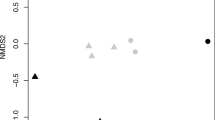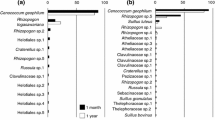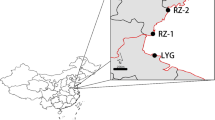Abstract
Background and aims
Ectomycorrhizal (ECM) fungal communities are affected by many abiotic and biotic factors, among which host identity is often regarded as the most significant. Although little about ECM fungal communities on endangered tree species is known, knowledge of their ECM associations could be a key to conservation given the functional importance of the symbiosis.
Methods
We collected 73 soil samples from three relict forests dominated by endangered Chinese Douglas-fir (Pseudotsuga sinensis). Identity of fungal and host species in individual ECM tips was determined by morphotyping and DNA analyses.
Results
Of the 86 ECM fungal species identified, 66 were observed on Chinese Douglas-firs. While the fungal composition did not significantly differ between coexisting trees (p = 0.843), the composition was significantly separated based on location (p = 0.021). Moreover, the observed ECM fungal communities were dissimilar to those on the Japanese Douglas-fir (p = 0.001), which is monophyletic to Chinese Douglas-fir.
Conclusions
Our results indicate that ECM fungal communities are determined more by geographical location than host monophyly on this spatial (c.770–1,600 km) and geological time scale ( c. 20–25 My). For conservation of endangered trees, it may be important to preserve local ECM fungal pools, irrespective of host species.


Similar content being viewed by others
References
Baar J, Horton TR, Kretzer AM, Brun TD (1999) Mycorrhizal colonization of Pinus muricata from resistant propagules after stand-replacing wildfire. New Phytol 143:409–418
Bahram M, Põlme S, Kõljalg U, Zarre S, Tedersoo L (2012) Regional and local patterns of ectomycorrhizal fungal diversity and community structure along an altitudinal gradient in the Hyrcanian forests of northern Iran. New Phytol 193:465–473
Bruns TD, Peay KG, Boynton PJ, Grubisha LC, Hynson NA, Nguyen NH, Rosenstock NP (2009) Inoculum potential of Rhizopogon spores increases with time over the first 4-yr of a 99-yr spore burial experiment. New Phytol 181(2):463–470
Cline ET, Ammirati JF, Edmonds RL (2005) Does proximity to mature trees influence ectomycorrhizal fungus communities of Douglas-fir seedlings? New Phytol 166(3):993–1009
Cox F, Barsoum N, Lilleskov EA, Bidartondo MI (2010) Nitrogen availability is a primary determinant of conifer mycorrhizas across complex environmental gradients. Ecol Lett 13:1103–1113
Eckenwalder JE (2009) Conifers of the world. Timber Press, Portland
Erland S, Finlay R (1992) Effects of temperature and incubation time on the ability of three ectomycorrhizal fungi to colonize Pinus sylvestris roots. Mycol Res 96:270–272
Farjon A (1990) Pinaceae: drawings and descriptions of the Genera Abies, Cedrus, Pseudolarix, Keteleeria, Nothotsuga, Tsuga, Cathaya, Pseudotsuga. Koeltz Scientific Books, Königstein
Fu LK (1992) China plant red data book: rare and endangered plants: volume 1. Science Press, Beijng
Fu LK, Li N, Mill RR (1999) Pseudotsuga. In: Wu ZY, Raven PH (eds) Flora of China, vol 4. Science Press and Missouri Botanical Garden, Beijing, pp 33–37
Gardes M, Bruns TD (1993) ITS primers with enhanced specificity for basidiomycetes—application to the identification of mycorrhizae and rusts. Mol Ecol 2:113–118
Guo W, Shen RJ, Wu JH, Liao WB, Peng SL, Chen H (2007) Analysis on community composition and structure of Pseudotsuga gauseni in Sanqing Mountain of Jiangxi Province (in Chinese). J Plant Resour Environ 16(3):46–52
Hiramatsu M, Ii K, Okubo H, Huang KL, Huang CW (2001) Biogeography and origin of Liliumlongiflorum and L-formosanum (Liliaceae) endemic to the Ryukyu Archipelago and Taiwan as determined by allozyme diversity. Am J Bot 88(7):1230–1239
Hobbie EA (2006) Carbon allocation to ectomycrrhizal fungi correlates with belowground allocation in culture studies. Ecology 87:563–569
Horton TR, Bruns TD (1998) Multiple-host fungi are the most frequent and abundant ectomycorrhizal types in a mixed stand of Douglas-fir (Pseudotsuga menziesii D. Don) and bishop pine (Pinus muricata. D. Don). New Phytol 139:331–339
Horton TR, Bruns TD (2001) The molecular revolution in ectomycorrhizal ecology: peeking into the black-box. Mol Ecol 10:1855–1871
Horton TR, Molina R, Hood K (2005) Douglas-fir ectomycorrhizae in 40- and 400-year-old stands: mycobiont availability to late successional western hemlock. Mycorrhiza 15(6):393–403
Hotta M (1974) Evolutionary biology in plants. III. History and geography of plants (in Japanese). Sanseido Co, Tokyo
Huang J, Nara K, Zong K, Wang J, Xue S, Peng K, Shen Z, Lian C (2014) Ectomycorrhizal fungal communities associated with Masson pine (Pinus massoniana) and white oak (Quercus fabri) in a manganese mining region in Hunan Province, China. Fungal Ecol 9:1–10
Ishida T, Nara K, Hogetsu T (2007) Host effects on ectomycorrhizal fungal communities: insight from eight host species in mixed conifer–broadleaf forests. New Phytol 147:430–440
Izzo A, Canright M, Bruns TD (2006) The effects of heat treatments on ectomycorrhizal resistant propagules and their ability to colonize bioassay seedlings. Mycol Res 110:196–202
Jarvis S, Woodward S, Alexander IJ, Taylor AFS (2013) Regional scale gradients of climate and nitrogen deposition drive variation in ectomycorrhizal fungal communities associated with native Scots pine. Glob Chang Biol 19:1688–1696
Kasai S, Saito M (2009) Distribution and suitable site of Pseudotsuga japonica in Mie prefecture (in Japanese). Chubu For Res 57:55–56
Kinoshita A, Sasaki H, Nara K (2012) Multiple origins of sequestrate basidiomes within Entoloma inferred from molecular phylogenetic analyses. Fungal Biol 116:1250–1262
Koide RT, Fernandez C, Malcolm G (2014) Determining place and process: functional traits of ectomycorrhizal fungi that affect both community structure and ecosystem function. New Phytol 201:433–439
Kretzer A, Li YN, Szaro T, Bruns TD (1996) Internal transcribed spacer sequences from 38 recognized species of Suillus sensulato: phylogenetic and taxonomic implications. Mycologia 88:776–785
Lande (1993) Risk of population extinction from demographic and environmental stochasticity and random catastrophes. Am Nat 142(6):911–927
Lang C, Seven J, Polle A (2011) Host preferences and differential contributions of deciduous tree species shape mycorrhizal species richness in a mixed Central European forest. Mycorrhiza 21(4):297–308
Lilleskov EA, Fahey TJ, Horton TR, Lovett GM (2002) Belowground ectomycorrhizal fungal community change over a nitrogen deposition gradient in Alaska. Ecology 83(1):104–115
Luoma DL, Stockdale CA, Molina R, Eberhart JL (2006) The spatial influence of Douglas-fir retention trees on ectomycorrhiza diversity. Can J Forest Res 36:2561–2573
MacArthur RH, Wilson EO (1967) The theory of island biogeography. Princeton University Press, New Jersey
McCune B, Mefford MJ (2011) PC-ORD. Multivariate analysis of ecological data. Version 6. MjM Software, Gleneden Beach, Oregon
Mikola P (1973) Application of mycorrhizal symbiosis in forestry practice. In Ectomycorrhizae-Their ecology and Pgysiology. Academic Press, New York, pp 383–411
Miyamoto Y, Nakano T, Hattori M, Nara K (2014) The mid-domain effect in ectomycorrhizal fungi: range overlap along an elevation gradient on Mount Fuji, Japan. ISME J 8:1739–1746
Molina R, Massicotte H, Trappe JM (1992) Specificity phenomena in mycorrhizal symbioses: community-ecological consequences and practical implications. In: Allen MF (ed) Mycorrhizal functioning: an integrative plant-fungal process. Chapman and Hall, New York, pp 357–423
Murata M, Kinoshita A, Nara K (2013) Revisiting the host effect on ectomycorrhizal fungal communities: implications from host–fungal associations in relict Pseudotsuga japonica forests. Mycorrhiza 23:641–653
Nara K (2006) Ectomycorrhizal networks and seedling establishment during early primary succession. New Phytol 169:169–178
Nara K, Nakaya H, Wu B, Zhou Z, Hogetsu T (2003) Underground primary succession of ectomycorrhizal fungi in a volcanic desert on Mount Fuji. New Phytol 159:743–756
Oksanen J, Blanchet FG, Kindt R, Legendre P, O’Hara RB, Simpson GL, Solymos P, Stevens MHH, Wagner H (2011) vegan: community ecology package. R package version 2.0-10 Available at http://CRAN.R-project.org/package=vegan
Ono M (1989) Phytogeography in Ogasawara and Ryukyu (Nansei) Islands (in Japanese). In: Miyawaki A (ed) Vegetation of Japan, vol. 10, Okinawa and Ogasawara. Shibundo Co., Tokyo, pp 127–137
Peay KG, Garbelotto M, Bruns TD (2009) Spore heat resistance plays an important role in disturbance-mediated assemblage shift of ectomycorrhizal fungi colonizing Pinus muricata seedlings. J Ecol 97(3):537–547
Põlme S, Bahram M, Yamanaka T, Nara K, Dai YC, Grebenc T, Kraigher H, Toivonen M, Wang P, Matsuda Y, Naadel T, Kennedy PG, Kõljalg U, Tedersoo L (2013) Biogeography of ectomycorrhizal fungi associated with alders (Alnus spp.) in relation to biotic and abiotic variables at the global scale. New Phytol 198:1239–1249
Pringle A, Bever JD, Gardes M, Parrent JL, Rillig MC, Klironomos JN (2009) Mycorrhizal symbioses and plant invasions. Annu Rev Ecol Evol Syst 40:699–715
Rinaldi AC, Comadini O, Kuyper TW (2008) Ectomycorrhizal fungal diversity: separating the wheat from the chaff. Fungal Divers 33:1–45
Rineau F, Courty PE (2011) Secreted enzymatic activities of ectomycorrhizal fungi as a case study of functional diversity and functional redundancy. Ann Forest Sci 68:69–80
Roy M, Rochet J, Manzi S, Jargeat P, Gryta H, Moreau PA, Gardes M (2013) What determines Alnus-associated ectomycorrhizal community diversity and specificity? A comparison of host and habitat effects at a regional scale. New Phytol 198:1228–1238
Selosse MA, Setaro S, Glatard F, Richard F, Urcelay C, Weiss M (2007) Sebacinales are common mycorrhizal associates of Ericaceae. New Phytol 174:864–878
Smith ME, Douhan GW, Fremier AK, Rizzo DM (2009) Are true multihost fungi the exception or the rule? Dominant ectomycorrhizal fungi on Pinus sabiniana differ from those on co-occurring Quercus species. New Phytol 182:295–299
Smith SE, Read DJ (2008) Mycorrhizal symbiosis, 3rd edn. Academic, Cambridge
Strauss SH, Doerksen AH, Byrne JR (1990) Evolutionary relationships of Doughlas-fir and its relatives (genus Pseudotsuga) from DNA restriction fragment analysis. Can J Bot 68:1502–1510
Taylor DL, Bruns TD (1999) Community structure of ectomycorrhizal fungi in a Pinus muricata forest: Minimal overlap between the mature forest and resistant propagule communities. Mol Ecol 8:1837–1850
Tedersoo L, Bahram M, Toots M, Diédhiou AG, Henkel TW, Kjøller R, Morris M, Nara K, Nouhra E, Peay KG, Põlme S, Ryberg M, Smith ME, Kõljalg U (2012) Towards global patterns in the diversity and community structure of ectomycorrhizal fungi. Mol Ecol 21:4160–4170
Tedersoo L, Jairus T, Horton BM, Abarenkov K, Suvi T, Saar I, Kõljalg U (2008) Strong host preference of ectomycorrhizal fungi in a Tasmanian wet sclerophyll forest as revealed by DNA barcoding and taxon-specific primers. New Phytol 180:479–490
Tedersoo L, May TW, Smith ME (2010) Ectomycorrhizal lifestyle in fungi: global diversity, distribution, and evolution of phylogenetic lineages. Mycorrhiza 20:217–263
Tedersoo L, Nara K (2010) General latitudinal gradient of biodiversity is reversed in ectomycorrhizal fungi. New Phytol 185(2):351–354
Tedersoo L, Suvi T, Beaver K, Kõljalg U (2007) Ectomycorrhizal fungi of the Seychelles: diversity patterns and host shifts from the native Vateriopsis seychellarum (Dipterocarpaceae) and Intsia bijuga (Caesalpiniaceae) to the introduced Eucalyptus robusta (Myrtaceae), but not Pinus caribea (Pinaceae). New Phytol 175:321–333
Twieg BD, Durall DM, Simard SW (2007) Ectomycorrhizal fungal succession in mixed temperate forests. New Phytol 176(2):437–447
Velmala SM, Rajala T, Haapanen M, Taylor AFS, Pennanen T (2013) Genetic host-tree effects on the ectomycorrhizal community and root characteristics of Norway spruce. Mycorrhiza 23:21–33
Wei XX, Yang ZY, Li Y, Wang XQ (2010) Molecular phylogeny and biogeography of Pseudotsuga (Pinaceae): insights into the floristic relationship between Taiwan and its adjacent areas. Mol Phylogenet Evol 55(3):776–785
Wu ZY, Raven PH (1999) Flora of China, volume 4, Cycadaceae through Fagaceae. Science Press and Missouri Botanical Garden, Beijing
Xiang QY, Soltis DE, Soltis PS (1999) The eastern Asian and eastern and western North American floristic disjunction: congruent phylogenetic patterns in seven diverse genera. Mol Phyl Evol 10(2):178–190
Acknowledgments
This research was funded by an award from the China Scholarship Council to ZW, by Japan Society for the Promotion of Science KAKENHI Grants to KN (25257411, 25660115, 25304026), and by an award from the National Natural Science Foundation of China-Guangdong Province Natural Science Foundation Joint Research Fund to YC (U1133004). We also thank Liang Shi, Haolin Zhu, and Qizhi Zha for their support in field sampling.
Conflict of Interest
The authors declare no conflict of interest associated with this manuscript.
Author information
Authors and Affiliations
Corresponding authors
Additional information
Responsible Editor: Duncan D. Cameron.
Electronic supplementary material
Below is the link to the electronic supplementary material.
Supplemental Fig. S1
(DOCX 571 kb)
Supplemental Fig. S2
(DOCX 987 kb)
Supplemental Fig. S3
(DOCX 6799 kb)
Supplemental Fig. S4
(DOCX 1243 kb)
Rights and permissions
About this article
Cite this article
Wen, Z., Murata, M., Xu, Z. et al. Ectomycorrhizal fungal communities on the endangered Chinese Douglas-fir (Pseudotsuga sinensis) indicating regional fungal sharing overrides host conservatism across geographical regions. Plant Soil 387, 189–199 (2015). https://doi.org/10.1007/s11104-014-2278-3
Received:
Accepted:
Published:
Issue Date:
DOI: https://doi.org/10.1007/s11104-014-2278-3




